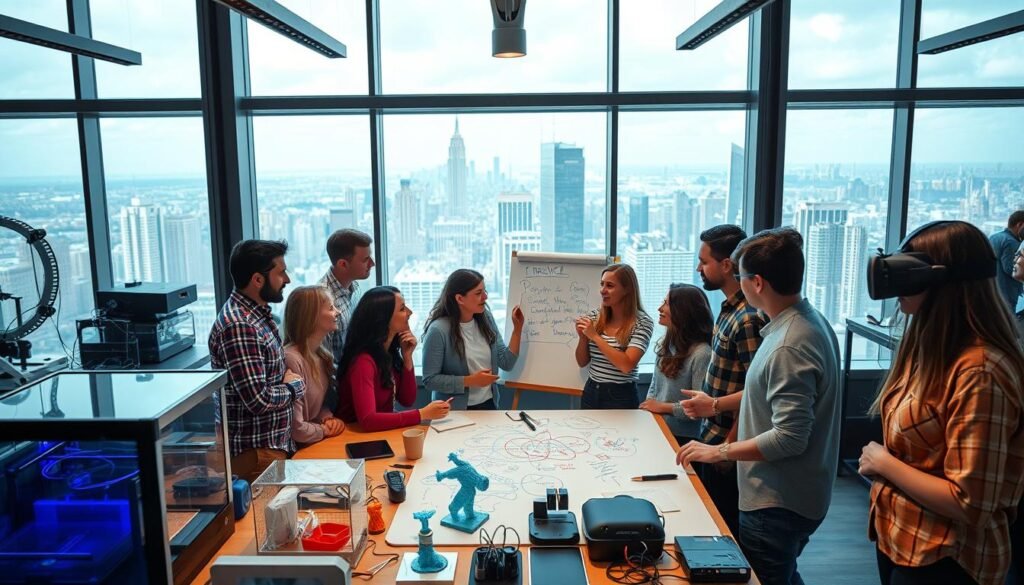Cultivating a Culture of Experimentation in the Workplace.
Did you know companies with a strong culture of experimentation do better? They outperform others by 20% in efficiency and productivity. This shows how important it is to let employees try new things and innovate. In today’s fast-changing business world, being able to adapt and succeed depends on embracing experimentation.
In today’s business world, staying the same is not enough. To keep up with new tech and changing markets, it’s key to encourage trying new things. Companies like Google and Amazon have grown by making experimentation a big part of their culture. This has led to big improvements and new ideas.
Key Takeaways
- Companies with a strong culture of experimentation outperform peers by 20% in operational efficiency and productivity.
- Experimentation is essential for staying competitive in an evolving business landscape.
- Prominent companies like Google and Amazon have successfully integrated experimentation into their culture.
- Encouraging a trial-and-error mindset leads to continuous improvement and innovation.
- Empowering employees to experiment can drive significant business growth.
The Importance of Experimentation in Modernizing Office Culture
In today’s fast-changing business world, creating a culture of experimentation is key. Companies that focus on innovation through trying new things can better keep up with changes. They stay ahead of the competition.
Why Experimentation Matters
Trying new things sparks innovation. It helps companies learn and adapt constantly. When employees can try out new ideas without fear of failure, it boosts creativity and problem-solving.
Google is a great example. It stays at the top thanks to its culture of innovation. Employees get 20% of their time to work on experimental projects.
Benefits for Workplace Innovation
There are many good things about making experimentation a part of work:
- Increased adaptability to market changes and what customers want.
- Enhanced employee engagement by letting them try new ideas.
- Improved problem-solving skills for everyone.
- Creating a culture of collaboration and sharing knowledge.
Also, experimenting lets companies test ideas fast and learn from them. This way, they only use the best strategies.
| Benefits of Experimentation | Description |
|---|---|
| Increased Adaptability | Companies can quickly adjust to changes and stay relevant. |
| Employee Empowerment | Employees feel valued and motivated to come up with new solutions. |
| Problem-Solving Skills | Teams learn strong ways to solve problems. |
| Collaboration and Knowledge Sharing | A culture where sharing information and ideas is encouraged. |
How Experimentation Drives Innovation Strategies
Experimentation is key in driving innovation in companies. It helps them explore new areas, stay ahead, and adjust to market changes. Looking at successful companies and their metrics offers valuable lessons.
Examples of Successful Companies
Many companies are known for their use of experimentation to boost innovation. For example:
- Google: Its “20% time” policy lets employees work on side projects. This led to big hits like Gmail and Google News.
- Amazon: Amazon uses A/B testing a lot. They try out different website features and product suggestions to improve user experience and sales.
- Netflix: Netflix relies on data to test its recommendation engine. This has greatly increased user engagement and kept people coming back.
Key Metrics to Measure Success
To see how well experimentation works, we need to track certain metrics. These show how effective and scalable changes are:
- Conversion Rate: Shows how many users take the desired action after changes are made.
- Customer Satisfaction: Uses tools like Net Promoter Score (NPS) to check how happy customers are with new things.
- Time to Market: Measures how fast new ideas and improvements are tested and put into use.
- Return on Investment (ROI): Looks at the financial gain from experiments compared to the cost, aiming for profit.
Fostering Creativity at Work Through Experimentation
Creating a space for creativity is key in today’s workplace. Experimentation boosts innovation and lets team members try new ideas without fear. This part talks about brainstorming and shares a story from The Telegraph on how it drives creativity.
Brainstorming Techniques that Foster Innovation
Good brainstorming techniques can really boost creativity at work. Here are some popular ones:
- Mind Mapping: This method makes a visual map of ideas. It helps spot connections and grow on initial thoughts.
- SCAMPER: SCAMPER stands for Substitution, Combination, Adaptation, Modification, Put to another use, Elimination, and Rearrangement. It challenges old ways of thinking to spark new ideas.
- Brainwriting: Team members write down their ideas instead of sharing them out loud. This lets thoughts flow freely without being interrupted.
- Rolestorming: Everyone takes on different roles to see a problem or project from many sides.
Story: The Telegraph’s Experimental Approach
The Telegraph, a top British newspaper, has taken a bold step to boost creativity. They set up a special team for experimenting. This team has launched many new projects.
One big move was going digital-first. This let The Telegraph quickly change with how people read news.
The team used A/B testing and looked at data to try out different headlines, images, and content layouts. These tests made the news more engaging and focused on the reader. The results were great, with more people reading and subscribing.
The Telegraph’s success shows how important it is to be creative and take risks. By trying new things and using creative brainstorming, companies can really grow and improve.
Innovation in the Workplace: The Role of Leadership
Leaders are key in creating an innovative workplace. They inspire and encourage creativity and trying new things.
Leadership’s Influence on Workplace Culture
Leaders set the culture by what they do and decide. Showing a commitment to innovation sends a strong message. They make sure everyone can share ideas and work together.

Leaders who value different views and inclusivity spark new ideas. A culture that rewards creativity can lead to big breakthroughs and stay ahead in the market.
Encouraging Risk-Taking
Risk-taking is vital for innovation. Leaders who support taking risks let their teams try new things without fear. This creates a safe space for growth and change.
| Company | Approach | Outcome |
|---|---|---|
| 20% Time Policy | Development of Gmail and Google News | |
| Amazon | Two-Pizza Team Rule | Continuous innovation in AWS |
| 3M | 15% Rule | Invention of Post-it Notes |
Innovative leaders know that taking risks with support can lead to great success. They help build a strong and adaptable culture.
Promoting Creative Thinking Among Employees
Encouraging creative thinking at work is key to innovation and staying ahead. It’s important to create a space where employees can share ideas freely. Regular brainstorming and open forums help build a vibrant, inventive culture.
It’s also vital to give employees the tools to explore new ideas. This means access to software, workshops, and inspiring materials. With the right support, employees are more likely to solve problems creatively and think differently.
Recognizing and rewarding creative efforts is also essential. It shows that their ideas are valued and encourages others to be creative too. You can reward innovative ideas in many ways, like employee of the month, bonuses, or public praise.
Leaders have a big role in promoting creative thinking. When they show innovative thinking, they inspire their teams. This approach helps create a forward-thinking organization.
| Strategy | Implementation | Benefit |
|---|---|---|
| Brainstorming Sessions | Regularly scheduled meetings | Encourages idea sharing |
| Resource Allocation | Access to software, workshops | Facilitates creative problem-solving |
| Recognition Programs | Awards, public acknowledgment | Motivates employees |
| Leadership Involvement | Leaders model innovative behavior | Inspires team creativity |
Steps to Cultivating Innovation in the Workplace
To build a culture of innovation, you need to take specific steps. This includes making experimentation a part of your daily work and always looking for ways to improve. Here are some strategies to help your company become more innovative.
Implementing Small Bets
Small, calculated risks can lead to big innovations. This method, called “small bets,” starts with small tests to see if ideas work before scaling up. Companies like Google have found success with this approach, letting teams test new ideas with little risk.
Continuous Learning and Adaptation
It’s important to keep learning and adapting to stay innovative. By supporting ongoing education and training, your team can handle quick changes and new technologies easily. Companies like Amazon make learning a big part of their culture, encouraging continuous improvement.

| Steps | Details | Example |
|---|---|---|
| Implementing Small Bets | Start with low-risk, high-potential projects | Google’s 20% time policy |
| Continuous Learning and Adaptation | Invest in ongoing education and training | Amazon’s Leadership Principles |
Case Study: Booking.com’s Homepage Redesign
Booking.com made a big change to their homepage to improve user experience. This case study looks at how they did it and what they learned.
Experiment Overview
Booking.com wanted to make their homepage better. They tested a new design against the old one using A/B testing. They watched how users interacted with the site, like how long they stayed and if they made a booking.
Outcomes and Insights
The results of Booking.com’s test were very telling. The new homepage made users more engaged and they left the site less often. More people also made bookings, showing the design worked well.
| Key Metric | Previous Design | Redesigned Homepage |
|---|---|---|
| User Engagement | 15% | 28% |
| Bounce Rate | 45% | 30% |
| Conversion Rate | 5% | 9% |
Booking.com’s experiment shows the power of testing and improving based on data. Their approach is a guide for others looking to better their online presence.
Driving Digital Experience Optimization Through Experimentation
Experimentation is key for modern businesses to stay ahead. They test and improve digital experiences to meet user needs. This ensures they are effective in meeting expectations.

Companies like Amazon and Netflix use experimentation to improve their digital interfaces. They test different versions to see what works best. This boosts engagement and customer satisfaction.
Focus on website layout, navigation, content, and load times for optimization. Testing these areas helps make decisions based on data. This improves the user experience.
Here’s a look at traditional vs. experimental approaches:
| Traditional Approach | Experimental Approach |
|---|---|
| Static designs | Iterative improvements |
| Gut-feeling decisions | Data-driven decisions |
| Minimal user feedback | Continuous user feedback |
| Long development cycles | Rapid iteration cycles |
Embracing experimentation helps businesses stay ahead in the digital world. It makes them adaptable and forward-thinking.
Encouraging Cross-Departmental Collaboration
Working together across different departments can really help a company grow. It breaks down walls and brings in fresh ideas. This leads to better teamwork, more creativity, and success for the business.
Breaking Down Silos
It’s key to break down silos for good teamwork. Silos can block communication and stop info from flowing. Here are ways to tear them down:
- Open Communication Channels: Make sure teams can talk to each other easily.
- Inter-Departmental Projects: Give teams tasks that need help from others.
- Team-Building Activities: Plan fun activities to help teams get to know each other.
Benefits of Diverse Perspectives
Having different views in the workplace is super valuable. It brings new ideas and ways to solve problems. Here are some big pluses:
| Benefit | Description |
|---|---|
| Enhanced Problem-Solving | Teams with diverse views can tackle problems from many sides, finding better solutions. |
| Increased Innovation | People from different backgrounds bring fresh ideas and creativity. |
| Improved Employee Engagement | Places where everyone’s voice is heard make employees happier and more likely to stay. |
Mistakes to Avoid When Fostering a Culture of Experimentation
Creating a culture of experimentation can lead to innovation and success. But, it’s key to avoid common mistakes. Knowing these pitfalls helps us avoid them.
Common Pitfalls
A big mistake is not having clear goals. Without them, experiments can go nowhere, wasting time and money. Also, if leaders don’t support it, employees might not want to help.
Fear of failure is another big issue. In some places, failing is seen as bad. This stops people from trying new things, leading to no growth.
How to Overcome Challenges
To beat these challenges, we need a few steps. First, set clear goals for each experiment. This keeps everyone focused and knows what to aim for.
Leaders must also support this culture. Their backing and participation motivate employees to do their best.
It’s also important to view failure as a chance to learn. Celebrate what you learn from failures. This way, you can keep trying new things and grow.
The Role of Data in Experimentation
Data plays a key role in today’s work world. It helps companies make smart choices, improve processes, and spark new ideas. Using data in experiments makes business plans more accurate and lowers the chance of unexpected problems.
Data-Driven Decision Making
Data-driven decisions are all about using data to guide actions. In experimentation, this method is essential for testing ideas and checking results. Big names like Amazon and Netflix use data to improve what they offer, making customers happier and profits higher. This way, companies can make choices based on facts, leading to growth.
Effective A/B Testing Methods
A/B testing is vital for comparing different approaches. It involves testing two versions of something to see which works best. To succeed, A/B testing needs careful planning and execution. It’s important to pick the right metrics, have enough data, and control outside factors. Good A/B testing leads to important insights and ongoing improvement.
Balancing Experimentation with Daily Operations
Adding a culture of experimentation to daily business life can be tough but worth it. Companies must find a balance to keep things running smoothly and stay innovative. Here are some important areas to pay attention to.
Maintaining Productivity
Keeping productivity high while encouraging experimentation is key. Leaders can help by:
- Setting Clear Goals: Make sure there are clear goals for both experiments and regular tasks.
- Efficient Resource Allocation: Give teams the right resources and time for their experiments.
- Periodic Reviews: Check often to see how experiments affect productivity.

Integrating Experimentation into Daily Routines
To make experimentation a part of everyday work, a plan is needed. Here’s how to do it:
- Create Experimentation Slots: Set aside time for teams to work on new projects.
- Encourage Open Communication: Keep everyone informed about what experiments are happening and why.
- Leverage Collaborative Tools: Use tools to track and manage experimental projects well.
Implementing Rapid Testing Methodologies
Rapid testing is key for innovation in work settings. It needs careful planning and the ability to change and get better over time.
The Lean Startup method is a good way to do this. It focuses on *building*, *measuring*, and *learning* fast. This way, you waste less and find good solutions quicker. You make changes based on what the data says, not on long plans.
Agile frameworks also help by making development cycles short. Teams can test and get feedback fast. This way, only the best ideas keep going.
Here’s a simple look at the good things and important parts of rapid testing:
| Benefits | Key Elements |
|---|---|
| Faster time to market | Short development cycles |
| Increased adaptability | Frequent iterations |
| Cost efficiency | Data-driven decisions |
| Enhanced innovation | Continuous feedback |
To get the most out of these methods, teams need to work together well. They should share goals and work as one. Also, a culture that likes trying new things and learning from mistakes is vital for ongoing innovation.
Building Resilience to Failure
Resilience is key for any company wanting to innovate and grow. It’s about seeing failure as a chance to learn and celebrating the risks taken. This mindset makes a workplace more dynamic and adaptable.
Embracing Failure as a Learning Opportunity
Failure is not always a bad thing. It can teach us a lot. By figuring out what went wrong, we can learn for the next time. Google shows how embracing failure can lead to new ideas.
“I’ve missed more than 9,000 shots in my career. I’ve lost almost 300 games. Twenty-six times, I’ve been trusted to take the game-winning shot and missed. I’ve failed over and over and over again in my life. And that is why I succeed.” – Michael Jordan
Celebrating Risks Taken
When we celebrate taking risks, we create a place where new ideas can flourish. Atlassian rewards teams for their bold moves. They see these efforts as the keys to new possibilities.
Maintaining an Innovative Work Environment
Creating a work environment that encourages innovation is key for growth. It helps companies stay ahead in fast-changing markets and meet customer needs.
Continuous Improvement
Improvement is ongoing. It means always looking to make things better in the workplace. This mindset pushes employees to find new ways to do things.
- Process Optimization: Making workflows smoother to cut down on waste.
- Technology Upgrades: Using the newest tools to increase efficiency.
- Feedback Mechanisms: Listening to and using feedback from everyone involved.
Encouraging a Growth Mindset
A growth mindset sees challenges as chances to learn and grow. This mindset boosts innovation and productivity.
- Training Programs: Giving tools for learning and moving up in careers.
- Open Communication: Creating a space where ideas can flow freely.
- Recognition Systems: Celebrating and rewarding new ideas.
By combining these strategies, companies can keep their work environment innovative. This supports ongoing improvement and a growth mindset among staff.
Conclusion
In today’s fast-paced work world, trying new things is essential. It’s not just nice to have; it’s a must. Companies that try and fail learn and grow a lot. They become leaders in their fields.
Being creative and working together across teams helps a lot. Using data to make decisions also brings big benefits. These steps lead to great results.
Leaders are key in making this happen. They encourage trying new things and see failure as a chance to learn. It’s important to keep trying without slowing down work too much.
Using quick tests and bouncing back from mistakes keeps companies flexible. This is important in a world that changes fast.
Companies that keep improving and learning stay ahead. They look at examples like Booking.com’s redesign to get ideas. These ideas help make work places better and help companies grow.
FAQ
Why is experimentation critical in modernizing office culture?
Experimentation keeps workplaces fresh and ready for new challenges. It makes the office a place of constant change and growth.
What are the benefits of workplace innovation through experimentation?
It boosts employee engagement and problem-solving skills. It also helps in creating new business strategies.
How do successful companies use experimentation to drive innovation strategies?
Companies like Google and Amazon test new ideas fast. They use data to improve their strategies quickly.
What are key metrics to measure the success of workplace innovation experiments?
Look at ROI, employee happiness, and how fast new products hit the market. Also, check what customers say.
What brainstorming techniques can foster innovation in the workplace?
Mind mapping, brainwriting, and the Six Thinking Hats method are great. They help come up with new ideas.
How did The Telegraph’s experimental approach benefit their creativity?
The Telegraph made their editorial process better. They also created new content that readers loved more.
What role does leadership play in fostering workplace innovation?
Leaders set the stage for taking risks and trying new things. They create a space where ideas can grow.
How can leaders encourage risk-taking among their teams?
Leaders should celebrate failures as chances to learn. They should also protect their teams from fear of failure.
What strategies can promote creative thinking among employees?
Hold brainstorming sessions often. Give creative tools and encourage teams to work together. This boosts creative thinking.
How does implementing ‘small bets’ contribute to cultivating innovation in the workplace?
Small bets are low-risk experiments. They can lead to big innovations when scaled up.
Why is continuous learning important for workplace innovation?
Learning keeps employees up-to-date with new trends. It helps the company stay ahead in the market.
How did Booking.com’s homepage redesign experiment provide valuable insights?
Booking.com tested different homepage designs. They learned what users liked best, making their site more engaging.
How can digital experience optimization benefit from experimentation?
Testing helps find the best digital experiences for users. This boosts satisfaction and keeps users engaged.
What are the benefits of cross-departmental collaboration?
Working together brings different views. This leads to more creative solutions and prevents creativity from being blocked.
What common pitfalls should be avoided when fostering a culture of experimentation?
Avoid unclear goals, not enough resources, and fear of failure. Fixing these issues makes experimenting smoother.
How does data-driven decision making support experimentation?
Data guides experiments in the right direction. It leads to better and more impactful results.
What are effective A/B testing methods for measuring success?
Set clear goals and test with enough people. Use good analytics tools to understand the results.
How can companies balance experimentation with daily operations?
Mix experimenting into regular work. Make time for both new ideas and daily tasks to stay productive.
Why is maintaining productivity important while experimenting?
Keeping up with daily tasks lets the business run smoothly. It also leaves room for exploring new ideas.
What are rapid testing methodologies, and how do they enhance innovation?
Methods like Agile and Lean speed up innovation. They make it faster to bring new ideas to market.
How can companies build resilience to failure in their teams?
Teach teams to learn from failures. Celebrate what they learn from mistakes. This makes them brave to try new things.
What does it mean to embrace failure as a learning opportunity?
Seeing failure as a chance to learn is key. Each failure teaches something valuable for the next success.
Why is continuous improvement vital for maintaining an innovative work environment?
Always getting better keeps the company and its people growing. It stops them from getting stuck and keeps them competitive.
How can fostering a growth mindset contribute to workplace innovation?
A growth mindset sees challenges as chances to learn. It encourages creativity and new ideas.




